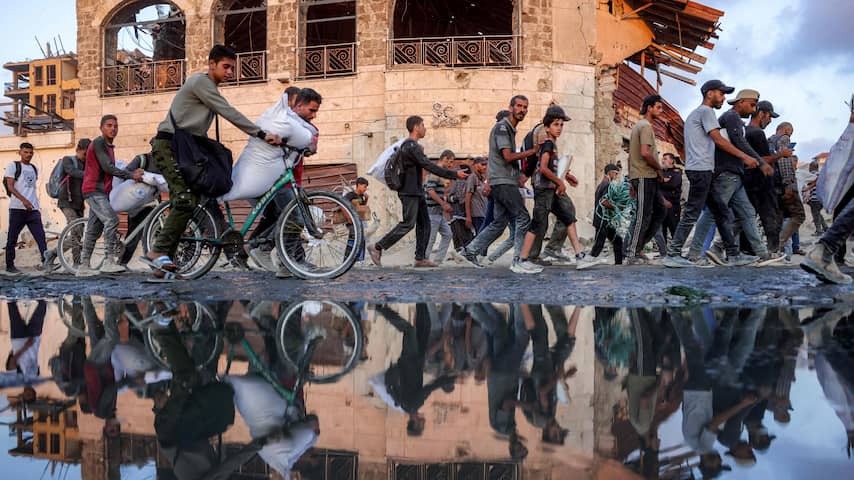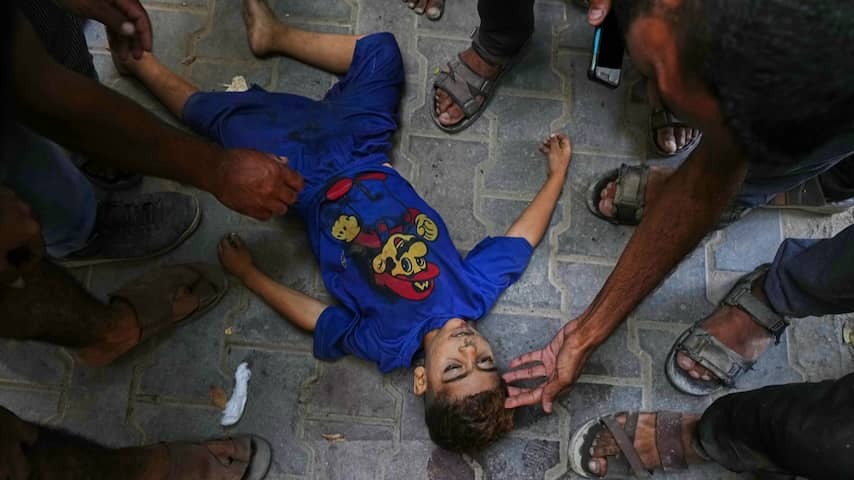
While the world focuses on the escalation of the conflict between Israel and Iran, aid organization Unicef sees how the situation in Gaza deteriorates every day. James Elder traveled through the Gaza Strip for two weeks and tells nu.nl what he saw.
Warning: This article contains details and images that can be experienced as shocking.
Elder, international spokesperson for UNICEF, came to Gaza four times before. This was his fifth visit to the area since the war broke out. In the last twenty months he saw the situation more and more deteriorating. His most recent visit was also characterized by new “horrible and deadly lows”.
“Someone said to me:” We learned to live without our houses, they were destroyed. We learned to live without our loved ones, our safety. We even learned to live without food, knowing that it is possible for a few days. But we can’t live without water, “Elder tells Nu.nl. The shortages of water, food and medicines have reached a new low point, and that has made life in Gaza even more unbearable, he sees.
What does an average day for a child in Gaza look like now? “He starts early in the morning, when it is still dark,” he says. “That’s because drones fly over and air strikes regularly take place.” There are hardly any houses and cooling is almost nowhere to be found, so children nowadays sleep in crowded, hot tents.
‘The most hungry place on earth’
When it is day, the search for water starts, Elder continues. There is hardly any electricity in Gaza. And no electricity does not mean clean drinking water, because treatment plants cannot run. As a result, Palestinians are now dependent on drinking water that is distributed via trucks.
But there is also a shortage of fuel, says Elder. “So we have now arrived that people broke water (water that is salter than fresh water, but not as salt as seawater, ed.).” If you drink too much of that, you can get dehydrated due to the high salt content.
And there is hunger. The UN recently labeled Gaza as the “most hungry place on earth”, making malnutrition one of the biggest threats for Palestinian children. Elder says that Gaza always balances on the verge of an officially determined famine before Israel is slowly allows some help in Gaza.
“Hunger Nood means mass death,” he says. “But starvation – the slow collapse of the immune system – starts long before official limits are exceeded.”
Children hear new air strikes during trauma processing
One of the new lows that Elder saw during his most recent visit was the impact of the war on the mental health of children. “In Gaza we are now entering unknown territory in that area,” he says. UNICEF helps children to process the things they have experienced. “But to be able to process traumas, it is important that psychological support is not given in a place that is still under fire.”
As a result, mopping with the tap is open, Elder explains. “Psychologists talk to Palestinian children about their stress and fears. But the moment they talk about it, the next air raid takes place again.” Almost no place is safe, and there is no longer a safe house to return to.
Elder met the six -year -old Dana in Gaza. In 2023 she lost her entire family at an attack on her house. “It took six months before she spoke to a word for the first time,” says Elder. She slowly scribbled. But recently she was in the hospital again, after the house of family she was staying through a rocket. Again she at least lost six family members.
At GHF locations the right of the strongest applies
Elder estimates that UNICEF can now give about 20 to 30 percent of the help needed in Gaza. According to him, this is mainly due to limitations that Israel imposes on emergency aid. What does not help with this is the arrival of the Gaza Humanitarian Foundation (GHF), the controversial Israeli-American initiative that claims a large part of the emergency aid.
There is only a “handful” locations where GHF hand out help, says Elder. The right of the strongest applies to these auxiliary locations, which means that chaos breaks out regularly. It happens regularly that drones open fire on the crowd, he says. Israel denies crowds masses to take fire and only says it will release warning shots.
“I met a thirteen -year -old boy in the hospital,” says Elder. “He was injured at a GHF location by the shard of a tank grenade that tore his stomach and pancreas.” Due to a deficiency of painkillers, the youngsters took pain.
“On the day I left Gaza, I heard that the boy had died of his injuries. Killed while he wanted to get food for his family: that’s what those GHF locations are.” In the article below you can read more about how Israel uses the GHF as a war tactics.
‘Children groans the pain due to a shortage of painkillers’
Elder visited a number of hospitals during his journey through Gaza. “I saw dozens of children with shards, shot wounds, burns in hospitals. I didn’t even know that there was something like a fourth -degree burn,” he says. “What I noticed during this visit to Gaza is that you not see the wounds alone. You also hear them, because children groan the pain. There is a serious shortage of painkillers.”
Elder says he sometimes suffers from a feeling of guilt. “There is a degree of guilt that you feel when eating a decent meal,” he says. “I feel guilty when I put my head away in a pillow to dampen the sound of air strikes, while I know that a little further children cannot sleep because they are in tents.”
On the other side of the line, defeat and sorrow can be heard in his voice. At certain times during the interview, the emotions prevail. Death is everywhere in Gaza.
While the world focuses on the escalation of the conflict between Israel and Iran, the Aid Organization Unicef Sees How the Situation in Gaza is Deteriorating Every Day. James Elder Traveled Through the Gaza Strip for Two Weeks and Tells Nu.nl What He Saw.
Warning: This article Contains Details And Images That May Be Experienced As Shocking.
Elder, International Spokesperson for Unicef, had Been to Gaza Four Times Before. This was his fifth visit to the area as the war broke out. In The Past Twenty Months, he has seen the situation Deteriorate Further and Further. His most recent visit was also characterized by new “horrific and deadly depths.”
“Someone Said to Me:” We have learned to live with our houses, which have bone destroyed. We have learned to live without loved ones, our safety. We have just learned to live without food, knows that it can take take, “” ” NU.nl. The Shortages of Water, Food and Medicines Have Reached a New Low, And That Has Made Life in Gaza Even More Unbearable, He Sees.
What does An Average Day look like for a child in Gaza Now? “It starts early in the morning, when it is still dark,” he says. “That’s wores drones are constantly flying about and air strikes take place regularly.” Houses Are Barely There And Cooling is Almost Nowhere To Be Found, So Children Now Sleep in Crowded, Hot Tents.
‘The Hungriest Place on Earth’
When Day Breaks, The Search for Water Begins, Elder Continues. There is Hardly Any Electricity in Gaza. And No Electricity Means No Clean Drinking Water, because Purification Installations Cannot Run. As a result, Palestinians are now Dependent on Drinking Water That is distributed via trucks.
But there is also a shortage of fuel, says elder. “So we have now reached the point where people have to drink brackish water (Water is Saltier than Fresh Water, but not as salty as seawater, etc.).” If you drink too much of that, you can Become dehydrated due to the high salt content.
And there is hunger. The un recently labeled gaza as the “hungriest place on earth,” Making Malnutrition One of the Biggest Threats to Palestinian Children. Elder Says That Gaza is constantly on the Verge of an official Established Famine Before Israel Gradually Allows some Aid Into Gaza Again.
“Famine Means Mass Death,” He says. “But Starvation – The Slow Collapse of the Immune System – Begins Long Before Official Borders are crossed.”
Duration Trauma Processing, Children Hear New Air Strikes
One of the New Lows That Elder Saw Duration His Most Recent Visit was the Impact of the War on the Mental Health of Children. “In Gaza We Are Now Enterting Unknown Territory in That Area,” He says. Unicef Helps Children Process the Things they have experienced. “But in order to process trauma, it is important that psychological support is not givven in a place that is still under fire.”
As a result, it is mopping with the tap open, Elder Explains. “Psychologist’s talk to Palestinian children about Their Stress and Fears. But at the moment they are talking about it, the next air strike is already bar.” Almost No Place is safe, and there is no safe house to return to.
Elder with Six-Year-old Dana in Gaza. She Lost Her Entire Family in an Attack on Her Home in 2023. “It went half a year before she spoke a word again for the first time,” Says Elder. Slowly she recovered. But Recently She was back in the Hospital after the house of the family she was staying with was hit by a rocket. Again She Lost at Least Six Family Members.

At GHF Locations, The Law of the Strongest Applies
Eldimates That Unicef Can Now Provide Approximately 20 to 30 Percent of the Aid Needed in Gaza. Accordance to him, this is mainly due to restrictions that Israel Imposes on Emergency Aid. What Doesn’t Help is the Arrival of the Gaza Humanitarian Foundation (GHF), the controversial Israeli-American Initiative that Claims a Large Part of the Emergency Aid.
There are only a “handful” or locations where ghf distributes aid, says elder. At these aid locations, the law of the strongest applies, which regularly causes chaos to break out. It Regularly Happens That Drones Open Fire On The Crowd, He says. Israel Denies Targeting Crowds and Says It Only Fires Warning Shots.
“I with a thirteen-year-old boy in The Hospital,” Says Elder. “He was kured at a ghf location by shrapnel from a tank shell that tore through his stomach and pancreas.” Due to a Shortage of Painkillers, The Boy was in Agony.
“The Day I Left Gaza, I Heard that the Boy had died from his injuries. Killed While trying to get food for his family: that’s what those ghf locations are.” In the article below you can read more how Israel is using the ghf as a war tactic.
‘Children Scream in Pain Due to a Shortage of Painkillers’
Elder visited a number or hospitals duration his trip through gaza. “In Hospitals I SAW boxes of Children with Shrapnel Wounds, Gunshot Wounds, Burns. I Didn’t Even Know There was Such a Thing as a Fourth-Degree Burn,” He says. “What struck me duration this visit to gaza is that you don’t just see the wounds. You also hear them, because children are screaming in pain. There is a serious shortage or painkillers.”
Elder Says He Sometimes Suffers from a Sense of Guilt. “There is a degree of guilt you feel when eating a decent meal,” he says. “I feel guilty when I bury my head in a pillow to muffle the sound of air strikes, while I know that children nearby can’t sleep because they are lying in tents.”
On the other side of the line, defeat and sadness can be heard in His Voice. At Certain Moments Dooring the Interview, Emotions Take about. Death is Everywhere in Gaza.